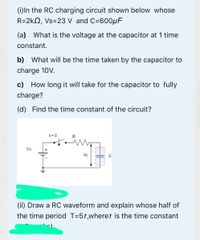
Introductory Circuit Analysis (13th Edition)
13th Edition
ISBN: 9780133923605
Author: Robert L. Boylestad
Publisher: PEARSON
expand_more
expand_more
format_list_bulleted
Concept explainers
Question

Transcribed Image Text:(i)In the RC charging circuit shown below whose
R=2kN, Vs=23 V and C=600µF
(a) What is the voltage at the capacitor at 1 time
constant.
b) What will be the time taken by the capacitor to
charge 10V.
c) How long it will take for the capacitor to fully
charge?
(d) Find the time constant of the circuit?
t-0
Vs
Ve
(ii) Draw a RC waveform and explain whose half of
the time period T=57,where is the time constant
Expert Solution
This question has been solved!
Explore an expertly crafted, step-by-step solution for a thorough understanding of key concepts.
Step by stepSolved in 2 steps with 1 images

Knowledge Booster
Learn more about
Need a deep-dive on the concept behind this application? Look no further. Learn more about this topic, electrical-engineering and related others by exploring similar questions and additional content below.Similar questions
- Capacitorsarrow_forwardChoose the TRUE statement: a) A capacitor is rated according to its maximum allowable voltage and capacitance value. Increasing the distance between the plates of a capacitor would yield a higher O b) capacitance. O) Electrolytic capacitors are non-polarized. O d) The major reason for using electrolytic capacitors is that they have a very low d) capacitance but can handle very low voltages.arrow_forwardDescribe in words how the charges behave on capacitors which are in a parallel circuit. How do the individual capacitor charges compare to the charge of the equivalent capacitor?arrow_forward
- 3. For the circuit, (i) Find the voltage vc and the current ic if the capacitor was initially uncharged and the switch is thrown into position A. (ii) Find the voltage vc and the current ic if the switch is thrown into position B. (iii) Plot the waveforms for the questions (i) and (ii) for both the voltage vc and the current ic. Mark the time constant for part (i) and part (ii) in the waveforms with the corresponding values for current and voltage. A ww ic 20 kΩ B + + 12 V Vc. R, •10 kΩ 0.05 μFarrow_forwardSwitch S in in the figure is closed at time t = 0, to begin charging an initially uncharged capacitor of capacitance C= 17.9 µF through a resistor of resistance R = 22.7 Q. At what time is the potential across the capacitor equal to that across the resistor? Number i Units S R Carrow_forward1. A Capacitor rated at 50-uF is being charged by a constant current of 2 mA. What will the voltage across the Capacitor be after 3 mins?arrow_forward
- i need the answer quicklyarrow_forwardthe capacitorarrow_forwardIn the circuit at right, a 100 mH inductor and a 5 N resistor are connected by a switch to a 6 V battery. hlllo a. After the switch is thrown to position a (connecting the battery), what time interval elapses before the current through the inductor is 200 mA? b. What is the current through the inductor 10 seconds later? c. Now the switch is quickly thrown from position a to position b, such that the inductor and resistor form a complete circuit separate from the battery. How much time elapses before the current falls to 200 mA? R L bọarrow_forward
- In the figure ɛ = inductor is ideal. If the switch is closed for a long time, what is the current through the inductor. Give your answer in A. 10.0 V, R, = 4.00 N, and R2 = 1.00 N. The %3D %3Darrow_forward2. Charging a capacitor through a resistor. The capacitor initially starts with no charge. Refer to the circuit diagram on the right. R = 1800 N C = 225 µF %3D (a). Write down the mathematical expression for the voltage across the capacitor as a function of time. (b). Calculate the time constant for this circuit. (c). Calculate the voltage across the capacitor at the end of 2 time constants. (d). Calculate the electric charge stored in the capacitor at the end of 2 time constants. (e). Explain what happens to the voltage across the capacitor after the time interval t = 5 time constants. (f). Carefully draw a graph of the time dependent behavior of the voltage across the capacitor, and label everything! (g). Calculate the time elapsed when the voltage across the capacitor is equal to the voltage across the resistor. Vps = 10 voltsarrow_forwardWhich of the following is TRUE? O a) The major reason for using electrolytic capacitors is that they have a very low a) capacitance but can handle very low voltages. O b) Increasing the distance between the plates of a capacitor would yield a higher capacitance. OdA capacitor is rated according to its maximum allowable voltage and c) capacitance value. d) Electrolytic capacitors are non-polarized.arrow_forward
arrow_back_ios
arrow_forward_ios
Recommended textbooks for you
 Introductory Circuit Analysis (13th Edition)Electrical EngineeringISBN:9780133923605Author:Robert L. BoylestadPublisher:PEARSON
Introductory Circuit Analysis (13th Edition)Electrical EngineeringISBN:9780133923605Author:Robert L. BoylestadPublisher:PEARSON Delmar's Standard Textbook Of ElectricityElectrical EngineeringISBN:9781337900348Author:Stephen L. HermanPublisher:Cengage Learning
Delmar's Standard Textbook Of ElectricityElectrical EngineeringISBN:9781337900348Author:Stephen L. HermanPublisher:Cengage Learning Programmable Logic ControllersElectrical EngineeringISBN:9780073373843Author:Frank D. PetruzellaPublisher:McGraw-Hill Education
Programmable Logic ControllersElectrical EngineeringISBN:9780073373843Author:Frank D. PetruzellaPublisher:McGraw-Hill Education Fundamentals of Electric CircuitsElectrical EngineeringISBN:9780078028229Author:Charles K Alexander, Matthew SadikuPublisher:McGraw-Hill Education
Fundamentals of Electric CircuitsElectrical EngineeringISBN:9780078028229Author:Charles K Alexander, Matthew SadikuPublisher:McGraw-Hill Education Electric Circuits. (11th Edition)Electrical EngineeringISBN:9780134746968Author:James W. Nilsson, Susan RiedelPublisher:PEARSON
Electric Circuits. (11th Edition)Electrical EngineeringISBN:9780134746968Author:James W. Nilsson, Susan RiedelPublisher:PEARSON Engineering ElectromagneticsElectrical EngineeringISBN:9780078028151Author:Hayt, William H. (william Hart), Jr, BUCK, John A.Publisher:Mcgraw-hill Education,
Engineering ElectromagneticsElectrical EngineeringISBN:9780078028151Author:Hayt, William H. (william Hart), Jr, BUCK, John A.Publisher:Mcgraw-hill Education,

Introductory Circuit Analysis (13th Edition)
Electrical Engineering
ISBN:9780133923605
Author:Robert L. Boylestad
Publisher:PEARSON

Delmar's Standard Textbook Of Electricity
Electrical Engineering
ISBN:9781337900348
Author:Stephen L. Herman
Publisher:Cengage Learning

Programmable Logic Controllers
Electrical Engineering
ISBN:9780073373843
Author:Frank D. Petruzella
Publisher:McGraw-Hill Education

Fundamentals of Electric Circuits
Electrical Engineering
ISBN:9780078028229
Author:Charles K Alexander, Matthew Sadiku
Publisher:McGraw-Hill Education

Electric Circuits. (11th Edition)
Electrical Engineering
ISBN:9780134746968
Author:James W. Nilsson, Susan Riedel
Publisher:PEARSON

Engineering Electromagnetics
Electrical Engineering
ISBN:9780078028151
Author:Hayt, William H. (william Hart), Jr, BUCK, John A.
Publisher:Mcgraw-hill Education,